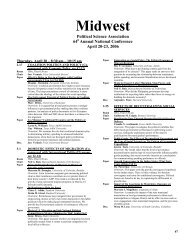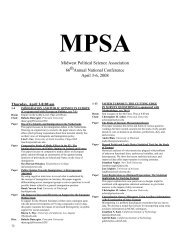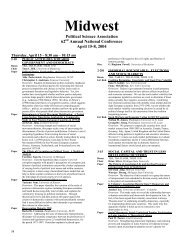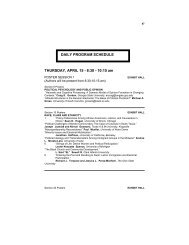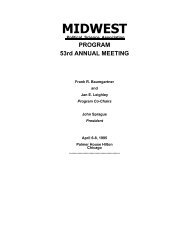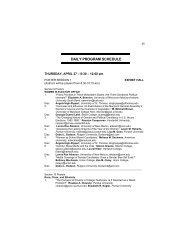2007 Conference Program - Midwest Political Science Association
2007 Conference Program - Midwest Political Science Association
2007 Conference Program - Midwest Political Science Association
You also want an ePaper? Increase the reach of your titles
YUMPU automatically turns print PDFs into web optimized ePapers that Google loves.
Paper Explaining the Increased Polarization in the U.S. Congress<br />
Daniel M Butler, Stanford University<br />
Overview: I model candidates facing the choice between<br />
mobilizing their base or persuading swing voters. I test the model<br />
both cross-sectionally and over time and show how changes in the<br />
two parties’ bases have led to increased congressional<br />
polarization.<br />
Paper Candidate Valence and Ideological Positioning in U.S. House<br />
Elections<br />
Walter J. Stone, University of California, Davis<br />
Elizabeth Simas, University of California, Davis<br />
Cherie D. Maestas, Florida State University<br />
L. Sandy Maisel, Colby College<br />
Overview: The purpose of our paper is to explore the relationships<br />
between candidate's valence-based strategies and positioning on<br />
the left-right scale in U.S. House elections.<br />
Disc. Tracy Sulkin, University of Illinois, Urbana-Champaign<br />
Robert Jackson, Florida State University<br />
41-3 RESPONDING TO PRINCIPALS AND<br />
PRECEDENTS (Co-sponsored with Public Law, see<br />
42-16)<br />
Room Burnham 1, 7 th Floor, Thur at 2:35 pm<br />
Chair Paul M. Collins, University of Houston<br />
Paper Supreme Court Monitoring Via GVRs<br />
Sara C. Benesh, University of Wisconsin, Milwaukee<br />
Jennifer K. Luse, University of Wisconsin, Milwaukee<br />
Amanda Schaefer, University of Wisconsin, Milwaukee<br />
Nicole Simmons, University of Wisconsin, Milwaukee<br />
Overview: In this paper, we consider use of Grant, Vacate, and<br />
Remand dispositions by the U.S. Supreme Court as a cost<br />
effective means by which it can monitor its agents (the lower<br />
courts).<br />
Paper Comparing the Influence of the Courts on NLRB Rulings<br />
Robert M. Howard, Georgia State University<br />
Cole Taratoot, Georgia State University<br />
Overview: Examining cross sectional time series data from 2000<br />
until 2000 we analyze the influence of the Supreme Court and<br />
Courts of Appeals on Administrative Law Judge Rulings on the<br />
NLRB.<br />
Paper Dynamic Deference in the Judicial Hierarchy<br />
Maxwell H. Mak, Stony Brook University<br />
Overview: Using the principal-agent framework, I examine the<br />
relationship between Supreme Court and Circuit Court liberalism.<br />
I test whether the circuit courts are sensitive to Court liberalism<br />
and to what degree that sensitivity exists in judicial hierarchy.<br />
Paper The U.S. Supreme Court As Agent: Rethinking Court<br />
Hierarchy<br />
Charles A. Smith, University of Miami<br />
Overview: The Supreme Court is configured as the Agent and the<br />
lower courts Principals, supported by a theoretical argument,<br />
empirical data, and a formal model.<br />
Paper Deference or Defiance: Explaining Court of Appeals Decision<br />
Making During the Rehnquist Era<br />
Nathaniel R. Vanden Brook, Western Michigan University<br />
Mark S. Hurwitz, Western Michigan University<br />
Ashlyn K. Kuersten, Western Michigan University<br />
Overview: Current research does not account for the long leash<br />
given to the circuit courts upon the elevation of William Rehnquist<br />
to Chief Justice. During Rehnquist’s tenure as Chief, the number<br />
of cases from the appellate courts that were granted cert<br />
diminished.<br />
Disc. Paul M. Collins, University of Houston<br />
Chad Westerland, University of Arizona<br />
42-2 COMPARATIVE LAW, LEGITIMACY, AND<br />
CONSTITUTIONAL DESIGN (Co-sponsored by<br />
Comparative Politics: Industrialized Countries, see 2-<br />
16)<br />
Room Clark 5, 7 th Floor, Thur at 2:35 pm<br />
Chair Rhonda L. Evans-Case, East Carolina University<br />
Paper Constitution, Legitimacy, and Democracy in Turkey<br />
M. F. Bilgin, Sakarya University<br />
Overview: In this work, I develop a notion of constitutional<br />
legitimacy vis-à-vis the idea of democracy and apply this notion to<br />
Turkey.<br />
Paper National Human Rights Institutions in the Courts: A<br />
Comparative Study<br />
Rhonda L. Evans Case, East Carolina University<br />
Overview: This paper examines the role of National Human<br />
Rights Institutions in the institutionalization of human rights<br />
principles at the national level and explores the ways in which<br />
NHRIs can be consequential politico-legal actors through the<br />
courts.<br />
Paper Tuning: Constitutional Emplotment under the Confucian Rule<br />
of Ritual<br />
Jin-Ha Kim, University of Chicago<br />
Overview: Can the pursuit of power promote ethical personality,<br />
which retains elective affinity with civic virtues? This paper<br />
examines the Confucian ecomusical principle of ‘Tuning’ and the<br />
Chosen Korean case of ritual constitutionalism.<br />
Paper Whose Community? Same-Sex Jurisprudence in the U.S,<br />
Germany and South Africa<br />
Jeremy H. Rabideau, University of Notre Dame<br />
Richard Ledet, University of Notre Dame<br />
Overview: The comparative jurisprudences of the United States,<br />
Germany, and South Africa in the domain of same-sex rights are<br />
analyzed and reflected back to Thomistic notions of natural law.<br />
Paper Quality of the Judiciary vs. Corruption Perception: A<br />
Comparative Analysis<br />
Raul A. Sanchez Urribarri, University of South Carolina<br />
Overview: This work discusses the impact of judicial quality on<br />
corruption perception, within a worldwide cross-section sample of<br />
countries. It addresses theoretical questions with respect to this<br />
relationship, and uses a quantitative model to explore it.<br />
Disc. David M. Speak, California Polytechnic University, Pomona<br />
42-14 RIGHTS, INTERNATIONAL LAW, AND<br />
CONTEMPORARY CRISES<br />
Room Dearborn 1, 7 th Floor, Thur at 2:35 pm<br />
Chair Emilia Powell, Georgia Southern University<br />
Paper What Happens When Institutions Attempt To Quash Habeas<br />
Corpus?<br />
Dana R. B. Adams, University of Minnesota<br />
Overview: Why did the number of federal habeas corpus cases<br />
spike following enactment of the AEDPA? I offer a predictive<br />
model to solve this puzzle. Implications of AEDPA data for<br />
habeas in the War on Terror are discussed.<br />
Paper Judicial Ambiguity and Asylum Law in the United States<br />
Canada and Australia<br />
Rebecca Hamlin, University of California, Berkeley<br />
Overview: Domestic legislative context and administrative<br />
structure shape and constrain the way that international refugee<br />
law is interpreted by courts in the United States, Canada and<br />
Australia, leading to more ambiguity in some nations than in<br />
others.<br />
Paper Globalization and the Future of Constitutional Law<br />
David S. Law, University of San Diego & University of<br />
California, San Diego<br />
Overview: This paper explores the thesis that international<br />
competition for capital and skilled labor, self-interested emulation<br />
of the constitutional policies of hegemonic states, and pressures to<br />
conform to the norms and expectations of world culture are<br />
driving.<br />
Page | 115



